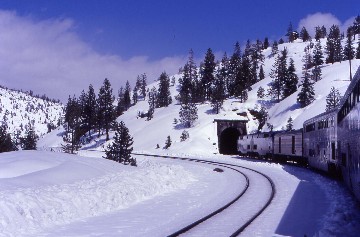
After my visit to Kentucky in December 2002, I thought I would need a trip for spring break and decided to go to Fort Worth, so looked at the baseball schedules for Texas Rangers, Chicago White Sox and Colorado Rockies. The Sox were not in town but the Rockies were. It then dawned on me that Denver had a new light rail system so why not ride Amtrak San Joaquin to Martinez, take the California Zephyr to Denver then to Chicago the next day? A Texas Eagle trip to Fort Worth would work followed by a two-night stay, where I could rent a car to see the Texas Rangers and ride the Grapevine Vintage Train. In addition, there was the Trinity Express to Dallas, DART Light Rail and the McKinney Avenue Streetcar that I could also ride.
Marty, my excellent Amtrak agent in Santa Ana, booked me a two-region See America Fare with a sleeper from Fort Worth to Los Angeles for my trip over the Sunset Route. Mike at AAA took care of my Texas car rental and I went online for my hotel rooms. Everything was finalized by the end of February, then I just lived my life until the night of departure for another exciting Amtrak trip.
Thruway Bus 4/18/2003My mother dropped me off at the Santa Ana Station after midnight for a 12:10 AM bus to Bakersfield. Departure time came and went, so after about twenty minutes I called the toll-free number and learnt that the bus was thirty-four minutes late out of Oceanside; not the way I wanted to start this journey, but then every trip is an adventure. The bus finally arrived at 12:46 and the six of us who had been waiting patiently, boarded and we were driven to Fullerton and then onto Los Angeles, exiting at 8th Street and taking Alameda Street north to Union Station. This was a really interesting way to go as there were former Southern Pacific tracks still in streets. Leaving LAUPT, we went to Glendale, where there was no sign of the very late-running Coast Starlight that had Ray Burns and Steve Grande of Trainweb onboard. The bus ran to Newhall, where no one boarded, but a long Union Pacificle double stack train blasted through, then we had a fast trip across the Ridge Route and arrived at 4:00 AM, fifty minutes before train time.
San Joaquin 711 4/18/2003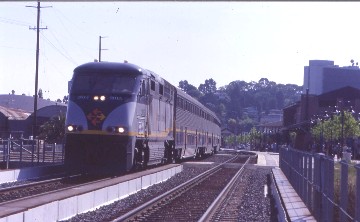
My car of choice was the cab car, "Point St George", which was a Pacific Surfliner car added to that order by Caltrain and it had the much more comfortable Pacific Surfliner seats. I was really looking forward to my ride north up the valley after the bus incident on my northbound Coast Starlight detour trip earlier this year. Our train was F59PHI 2015, coach 8021 "Kings River", coach 8013 "Klamath River", café 8812 "Sonoma Valley", coach 8010 "Truckee River" and 6965 "Point St. George".
We departed on time and I browsed the new spring/summer northeast timetable I picked up during my stay in Bakersfield, knowing that it would come in handy during my journey to this year's National Railway Historical Society convention in Baltimore. I napped from south of Shafter until Hanford where I purchased a chocolate chip muffin and a mint medley herbal tea which I enjoyed on the way to Fresno, then the sun rose at 6:31 AM on the day after a weather system passed through, providing a very beautiful morning. We left Fresno on time as I read the new issue of Rail Travel News while we passed through Madera and Merced. BNSF's eastbound fleet of trains were all tucked away in sidings out of our way as we flew by.
At Turlock-Denair, we did our station work before reversing down the main to enter the siding to let Amtrak San Joaquin 702 do its station work and once it arrived, we were on our way again. I read the Fresno Bee after a very attractive commuter left it on her seat after she detrained at Modesto. The new Stockton Intermodal Facility was running full bore as we approached Stockton and from here, we proceeded onto my favourite part of the former Santa Fe Valley Line, the trip across the San Joaquin delta country, where the San Joaquin River meets the Sacramento River. The Hetch-Hetchy water project crossed it with huge pipes and the land has been reclaimed for farming and sits much lower than the tracks on which I am riding. This is by far the most diverse region on this route. We crossed the Main Channel of the San Joaquin River at Middle River.
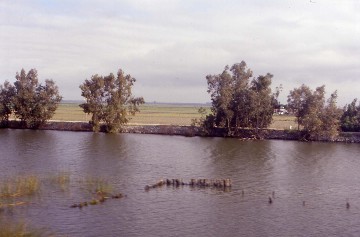
Further west down the rails at Orwood, Amtrak San Joaquin 712 was in the siding and to the southwest, the windmills of Altamont Pass could be seen and minutes later, Mount Diablo dominated the view to the south. We started our waterside-running as we neared Antioch, our next stop then crossed the Port Chicago Naval Weapons Station before crossing over to the former Southern Pacific Moccoco Line where we ran through the construction line of the expanded Interstate 680 bridge before reaching Martinez early. I visited the new Martinez depot before waiting my next train to arrive.
California Zephyr 6 4/18/2003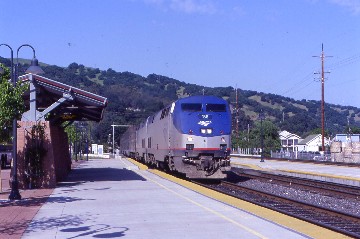
The California Zephyr arrived on time and I boarded the second coach and once underway, wee crossed the Martinez Drawbridge.
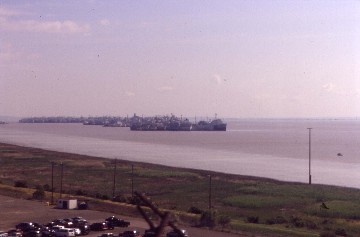
The United States Navy mothball fleet. We crossed the Suisan Wetland at a slow pace in order to have a good meet with a westbound Capitol Corridor train before we crossed over to meet a westbound Union Pacific freight which blew by us. We stopped briefly at Davis before another westbound Union Pacific freight passed. Then it was the Yolo Causeway, where the eastern end was flooded and we travelled through West Sacramento before crossing the Sacramento River into the Amtrak station.
As we curved out of Sacramento, I noticed two express refrigerator cars and two express cars on the rear of our train. We passed the boarded-up Elvas Tower before crossing the American River then crossed over and passed three more westbound Unin Pacific freights before reaching the very busy Union Pacific Roseville Yard, followed by the engine facility before we stopped at Roseville station. We proceeded up the eastbound line through Rocklin and started our journey into the very green Sierra foothills, going through Auburn and Colfax. Our train then traversed the Long Ravine bridge before it rounded Cape Horn where the American River was two thousand feet below. Another westbound Union Pacific train was encountered, followed by another one at Alta. Just below Blue Canon, we reached the snow line and the snowy scenes at Emigrant Gap were incredible as the train continued to climb on this sunny afternoon.

It is definitely a winter wonderland here in late April and the skiers were out in force at Soda Springs before we entered the snow shed at Norden, where an eastbound Union Pacific freight was waiting for us to enter Tunnel 41. We entered a world of darkness for a few minutes and when we exited, Donner Lake was far below and at Shed 47, the late-running westbound California Zephyr was waiting for us to clear with baggage car "Adirondack" in the consist. Further down at Cold Spring Canyon as we rounded the horseshoe curve, a westbound BNSF freight was climbing the grade west. We made our way to Truckee and then quickly lost our ground snow cover.
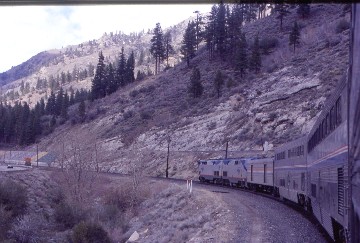
We followed the Truckee River into Nevada and on into Reno, where we were delayed in our arrival by a westbound Union Pacific freight blocking the station. Once he cleared, we pulled in and did our station work before continuing to Sparks for a crew change. I detrained here for a USA Today and to talk to the conductor about getting a room. We departed on time and travelled east through the lower Truckee River Canyon out to Fernley. Our conductor came and told me he had a room for $93.50, which I took. Roy, who had been my seatmate since Martinez, and I spent our time swapping stories while crossing Nevada. The desert scenery really caught my eye as well as the thunderstorms and dust storms in the area.
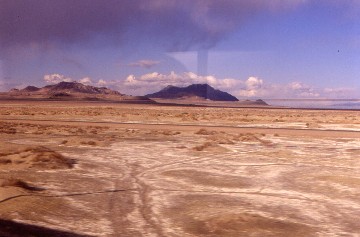
The crew called my dinner time just as the conductor came to settle with me on the room. I had a New York strip steak with an excellent chocolate bombe and fantastic dinner conversation then afterwards, moved to Room 8 in the 632 car, the last passenger car in our consist, and on the way there, met Jay who my sleeping car attendant. I freshened up and took my first Nevada sunset pictures from a train before Winnemucca; that sunset was awe-inspiring.
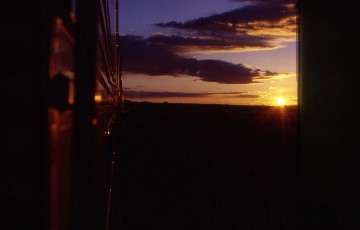
In twilight, we ran to Weso where we switched onto the former Western Pacific and the snow-capped mountains stood out in the northeast against the darkening sky. It has been a great day of train-riding and I was looking forward to tomorrow. I listened to music before calling it a night, made up my bed and fell asleep in Nevada.

4/19/2003 Waking up in Utah as we were climbing the Gilluly Loops, I went to the dining car for French Toast and sausage from Menu 2. Since April 1st, Amtrak now has three menus nationwide instead of just one. On my trips over the next two weeks, I will see how many times I will eat from this menu. We descended Soldier Summit and I photographed Castle Rock before going to the lounge car until we passed Price. Helper still looked as though it was a Denver and Rio Grande Western town with all the locomotives still in unaltered D&RGW paint.
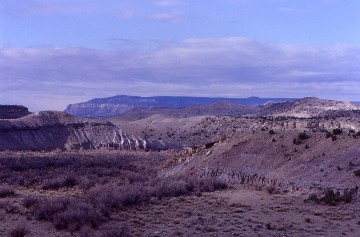
Our descent to Grassy before I returned to my room to relax and with the Book Cliffs outside my windows, I could not go wrong.
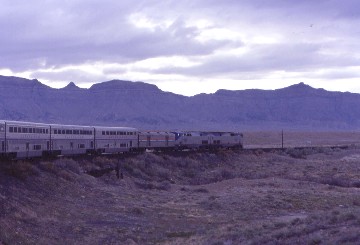
Sphinx siding, where you could always see a sphinx up on the cliffs. We dropped to Green River then crossed the divide to Thompson. U2's Joshua Tree album really added to the views since the theme of that album was the old west and I was seeing it as the song "God's Country" is playing and the title fit the view.
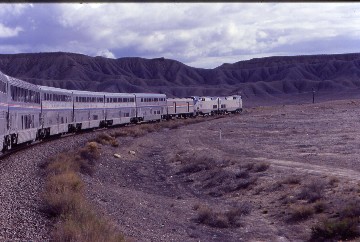
Over the next half hour, we descended to Westwater and its run along the Colorado River, starting with my favourite canyon of them all, Ruby Canyon.
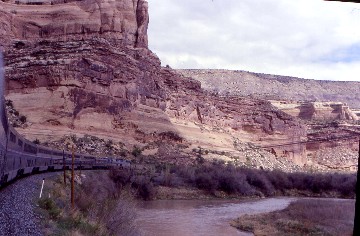
We travelled through Ruby and my camera was busy then we went through the short tunnel and entered the Grand Valley which we would run through to reach Grand Junction and our next crew change location. During the station stop, I bought packs of mixed agate and Mexican agates for Mrs. Angle, the best science teacher I know, as well as obtaining the train's consist: P42DCs 156 and 123, baggage 1253, transition sleeper 39028, coaches 34061 and 34039, smoking lounge 31053, lounge 33032, diner 38040, sleepers 32037 and 32000, with Express Cars 71178 and 71076 and refrigerator cars 74052 and 74091.
The horn was blown and I ran back the length of the train, huffing and puffing since I had forgogten that I was above 4,000 feet. Next time I will jump on at the first open door. As the train entered De Beque Canyon, I returned to taking pictures of our passage.

I was back in my room as the train made its way through the town of De Beque, relaxing, listening to music and feeling very lucky as I took in all this beautiful scenery. We travelled through Parachute as I wondered about its name. The town's name comes from Parachute Creek which runs through the township, before it merges with the Colorado River. The Ute people originally called the creek Pahchouc (meaning twins), with early settlers mispronouncing the word as parachute. In 1908, the town was renamed Grand Valley, but in the 1980's was changed back to Parachute.
I had an Angus beef burger for lunch finishing just as the Zephyr was departing Glenwood Springs. I was enjoying my picture-taking but two things made it hard. First, all the plants along the right-of-way had grown, and second, the heavy rain came but neither stopped me.
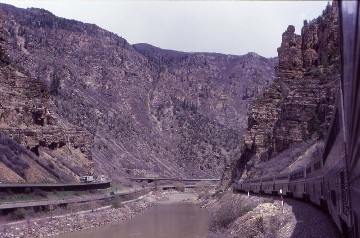
I returned to my room once we had finished our trek through Glenwood Canyon and all too soon, reached Dotsero and crossed the Eagle River back into the sunshine. We went into the siding at Range for the westbound California Zephyr before proceeding into Red Rock Canyon.
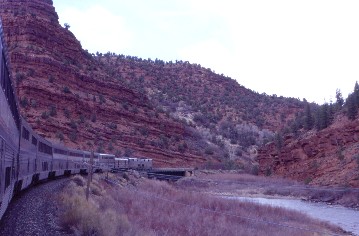
It has really helped make the last two days very relaxing knowing where all of the photo opportunities are along the line. In between, I just sat back and relaxed as I am on vacation? I walked forward and found Roy and we passed the time until Bond, a very busy place with both east and westbound coal trains ready to depart then made our way east as I listened to Black Sabbath.
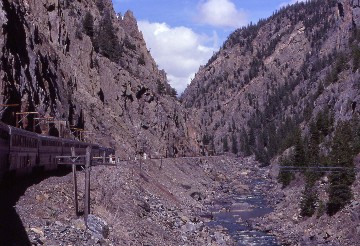
After our passage through Gore Canyon, our speed increased through Kremmling.
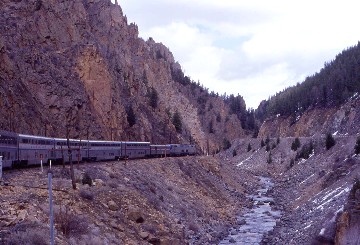
Passing through Byers Canyon, after which I enjoyed the ride to Granby, then we made our way through the short canyon before Tabernash and onto our next stop at Winter Park/Fraser before climbing the last miles of the grade, passing the Winter Park Ski Resort before plunging into Moffat Tunnel for fifteen minutes of darkness.
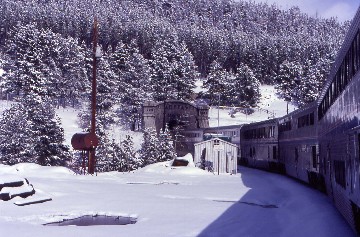
We came out of the tunnel to someone throwing snow balls at our train and proceeded to Tolland, where we entered the siding to let Union Pacific 8034 West clear then continued our eastbound descent in a light snow flurry outside our warm train. I ate at 5:30 PM as we descended the Front Range of the Rockies and had Brian as my server for every meal, an excellent and delightful waiter. We stopped briefly for about ten minutes before entering a tunnel and stopping again. I learned later this night from our engineer at the hotel that our lead locomotive had hit a boulder and damaged the front pilot, so much so that they had to replace the unit.
I enjoyed a repeat dinner of last night then the snow stopped at Plainview and we had a fairly clear view looking down onto the plains and rounded the Big Ten Curve as I took my final pictures of this part of the trip as we rounded the curve into Rocky.
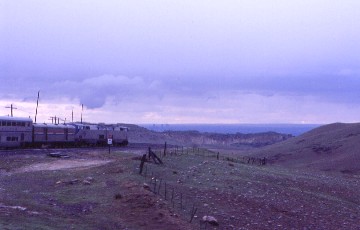
From there I just sat back, listened to music and relaxed the rest of the way to Denver, reversing into Denver Union Station at 7:15 PM, fifteen minutes early and after detraining, walked to the La Quinta Inn where I would spend the night.
Denver Light Rail 4/20/2003Opened on October 8th, 1994, this light rail system, operated by the Regional Transportation District, travels from 30th & Downing in Five Points, through downtown Denver and terminates at Interstate 25 & Broadway as the Central Corridor. It was extended along the Southwest Corridor in July 2000. Because it was the first and only line in the system, it had no letter or colour designation until the Central Platte Valley Spur opened on April 5, 2002, although, on maps, it was designated as Route 101. Its northern terminus is at 19th Street in Denver and on trips from Littleton, the line runs along 14th Street and California Street before reaching the northern terminus; on trips leaving downtown, the line goes along Stout Street and Colfax Avenue then runs along the Colorado Joint Line. The southern terminus is at Mineral Avenue in Littleton. Its fleet was Siemens SD-100 railcars.
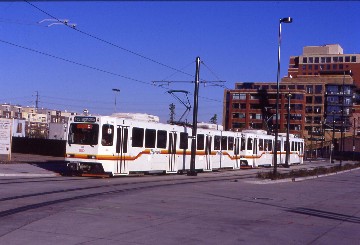
Up early on a beautifully clear Easter Sunday morning, I stopped at a MacDonald's Express to get hot cakes and sausage which I took back to the hotel's lobby then walked back over the bridge to the RTD-Downtown Civic Center station to photograph my train. After its station work was completed, the operator pulled down to a stub-end track to switch ends; this car only runs to Interstate 25 and Broadway, acting as a shuttle to the main route, 30th-Downing to Littleton-Mineral. Once aboard, we made an "S" curve to access the BNSF/UP Joint Line right-of-way and crossed Cherry Creek, after which our first stop was Pepsi Center, home of the Colorado Avalanche and Denver Nuggets, as well as the stop for Six Flags Elitch Gardens. We curved to the east to Invesco Field at Mile High, home of the Denver Broncos and the skyline of Denver was to the northeast. Our next stop was Auraria-West Campus then we turned south, joining the mainline and reached 10th and Osage right across from the former Denver and Rio Grande Western Burnham shops, where cars for the Ski Train were laying over. We then passed the RTD light rail shops before climbing a viaduct to Alameda, where I switched trains just as a southbound Union Pacific freight arrived, followed by a train to 30th Street, before I boarded a train to Littleton.

We proceeded to the Interstate 25/Broadway stop, racing the Union Pacific freight on the paralleling Joint Line then climbed up and over an industrial lead before reaching Evans. We passed the front of the freight and reached Englewood and continued to Oxford. I must say that this line does give one an excellent view of the Front Range of the Rockies. We climbed over the Joint Line on another flyover before reaching Littleton Downtown in a trench then proceeded to the final stop on the south end of the line at Littleton-Mineral. I detrained before the it went down to the end of a stub track to switch ends and once back aboard, relaxed and enjoyed the ride up to 10th and Osage, where I would continue the commentary.
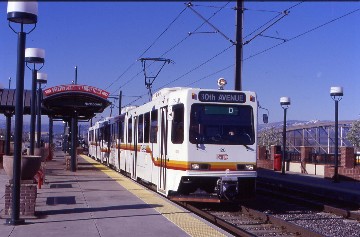
On the way north after Mineral, that southbound Union Pacific freight struggled by then we turned right onto new trackage after 10th and Osage and passed Auraria College before arriving at Colfax at Auraria station. From here, the line turned right into downtown Denver, crossing Cherry Creek then went underneath the Colorado Convention Center expansion building which was under construction, with Denver Center to the west, where a future stop was planned. We turned right onto a downtown loop stopping at 14th-California then turned left onto California, running on the right shoulder and stopping both at the 16th and 18th California Street station stops. At 16th Street, you could connect with the 16th Street free mall ride that takes you back to Union Station or east to the Civic Center Station on that route.
At 19th Street, we turned right to Welton Street where we continued north with stations at 20th, 25th, 27th and 29th/Welton. At 25th Street, the line became single track until 30th and Downing, where there is a two track station. Here I detrained while they switched ends and one train arrives before the next one leaves on its way back to Littleton-Mineral. After the layover, we proceeded south back to 19th Street, where this time we went one more block west to Stout Street and turned right, stopping at 18th, 16th, and 14th-Stout Street. Once we reconnected with the way we came out on the downtown loop, that was the complete Denver Light Rail system. I returned to 10th and Osage to catch a "C" Line train back to Union Station.
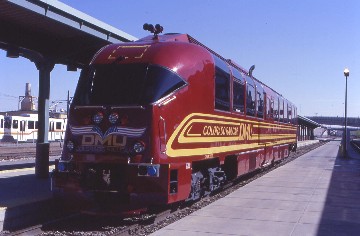
I visited Track 3 for Colorado Rail Car's Diesel Multiple Unit, or DMU. The self-propelled vehicle can pull two other coaches with their two 600 horsepower Detroit Diesel engines and the single-level vehicles can carry up to 92 passengers. Colorado Railcar had offered non-powered single and bilevel commuter coaches that had a high level of parts commonality with the DMU offerings. Around 2003, the company's DMU was being touted, as part of the Regional Transportation District FasTracks program, as a possible solution for the proposed Northwest Rail commuter line between Denver's Union Station and Boulder. The demonstration car was displayed at several locations for the public to visit, and the possibility of doing business with an in-state company seemed an added bonus and point of pride. Colorado Railcar DMU was targeted towards starter commuter rail operators with smaller passenger volumes desiring to operate shorter trains, often comparable to light rail, and with less extensive maintenance facilities. A DMU car could also pull two unpowered coach cars in addition to itself.
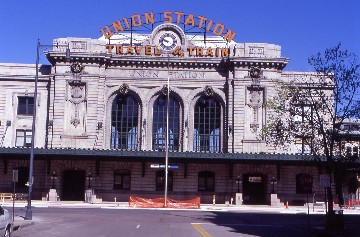
The street side view of Denver Union Station. In 1912, the original Union Depot partnership was dissolved and replaced by the Denver Terminal Railway Company, representing the then-major operators of the station (the Atchison, Topeka and Santa Fe, the Chicago, Burlington and Quincy, the Chicago, Rock Island and Pacific, the Colorado & Southern, the Union Pacific and the Denver & Rio Grande Western railways). The new partnership decided to demolish and rebuild the central portion of the station to handle the increasing passenger traffic. The new central portion, designed by Denver architects Gove & Walsh, was built in the Beaux-Arts style and opened in 1914.
By the 1920's and 1930's, over 80 trains served the station daily with notable dignitaries such as Queen Marie of Romania, Presidents Theodore Roosevelt, William Howard Taft and Franklin Delano Roosevelt arriving to Denver through the station. As a result of growing passenger service, the Mizpah Arch in front of the station was deemed a traffic hazard and was torn down in 1931. Although World War II saw a surge in rail traffic, the latter half of the 20th century saw a sharp decline in service for Union Station and countless other train stations in the United States as competition began to grow from automobiles and airlines.
For the first time in 1958, passenger traffic at Stapleton International Airport exceeded that of Union Station. It was during this period that the orange "Union Station: Travel by Train" signs were placed on both sides of the building to advertise intercity rail travel. Amtrak eventually became the sole provider of rail service through the station, operating only two trains daily between Chicago and the Bay Area with the California Zephyr. From the 1980's to the early 2000's, RTD, the City and County of Denver, the original site owner Denver Union Terminal Railway Corporation, and several other entities made periodic improvements such as accommodating an RTD bus lane to access Market Street Station from Interstate 25 and a light rail.
As I walked back to the La Quinta, I thought how lucky I was to be here on such a beautiful day. Since I had completed goal number one, which was the light rail system, at 11:30 AM, I was off to accomplish goal number two, a baseball game at Coors Field, and dropped off my bags at the front desk.
Colorado Rockies versus San Diego Padres 4/20/2003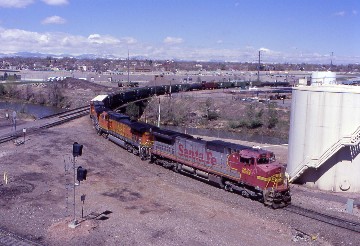
As I walked over the bridge to Coors Field, a BNSF freight just had to curve beneath me as I passed overhead.
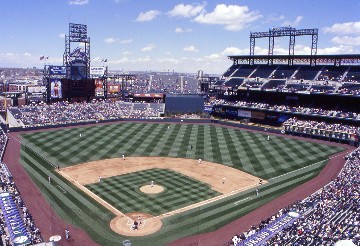
I entered the ballpark and made my way to the third deck walking to the northwest corner to enjoy the view of two BNSF freights passing on the Joint Line. To get my hot dogs in order to sample one in every ballpark I visit, I had to return to the lowest level then returned to my third deck seat right behind home plate and was pleased with my seat selection. Music selections vary from ballpark to ballpark, but I must say I enjoyed Jethro Tull's "Bungle in the Jungle" blasting loudly from the public address system. I watched the end of the Padres' batting practice and enjoyed my meal while also watching the ground crew prepare the field for play. Once the game started, we went two scoreless innings on the coldest day I have ever watched a baseball game. In the bottom of the second, Charles Johnson hit a two-run blast for Colorado, followed by a solo blast by Chris Stynes. The Rockies added another run in the third and two more in the fourth. For the seventh inning stretch, "God Bless America" was sung before the crowd sang "Take Me Out To The Ball Game". In the bottom of the seventh, Jay Payton hit a two-run blast for Colorado and the Padres tried to rally in the ninth, but it was all too late, losing to the Rockies 8-0 before 28,005 fans.
I walked back to the hotel and railfanned along the way to Denny's for a dinner of grilled chicken for a change of pace. It had been a great day and I was looking forward to my next train ride to Chicago. I taxied back to the station, checked in, finding that I was the first person to check in for the Zephyr, then stored my bags in a locker before walking to the Millennium Bridge.
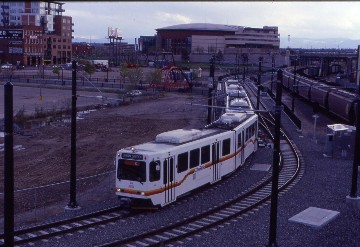
This location, whre light rail trains and Joint Line freights abound, is an excellent railfan location, especially in the morning, providing a great view of Denver Union Station and downtown Denver.

I stayed there until I had my fill then returned to Union Station, reclaimed my bags and waited for my next train.
California Zephyr 6 4/20/2003Since I had boarding priority number 1, I was first out to the train and found my usual large window right hand side seat in the first coach in the consist. After stowing my gear, I found the former San Diegan conductor Tom Tuttle, who had moved to Denver with his wife Sonya, another former San Diegan conductor, who just had a little baby girl. Tom, being the proud parent, naturally shared pictures of his beautiful daughter Tanya Amber. I was not able to see Chris Nay, yet another former San Diegan conductor, who was based out of Salt Lake City, but seeing Tom again made the trip worthwhile. Tom and I caught up on a variety of topics before it was time to depart at 7:55 PM and we made our way out into the night as I said goodbye to Denver and thanked it for a great time. I listened to "Night Ranger", but the rocking and rolling actions of the train put me to sleep right after Fort Morgan.
4/21/2003 I awoke just as Zephyr was leaving Omaha to starting the run along the Missouri River. We crossed the Platte River while I was sitting in the dining car and once we crossed the Missouri River into Iowa, my breakfast of French Toast and sausage arrived but it was on paper plates and with plastic utensils, which was not standard practice. Back at my coach seat, I saw the former Rock Island Spine Line on which I rode on behind Union Pacific 3985 last June. My book for this trip was John Grisham's "King of Torts". As we crossed Iowa, the sky grew cloudy which put me on storm watch then we arrived at Ottumwa thirty minutes early.
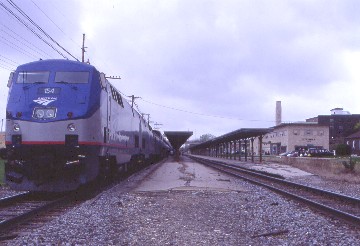
Our train with the Adirondack baggage car and our early arrival also allowed for a visit inside the depot. This is the same consist I had seen on Donner Pass two days ago. We made our way on time the rest of the way across Iowa to Burlington, where we crossed the Mississippi River into Illinois.
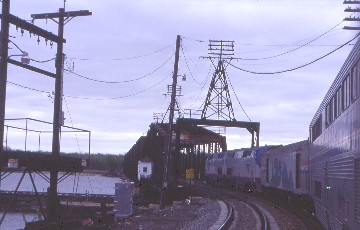
We continued our on-time running across Illinois with just a few sprinkles along the way, but the sky was waiting to drop its load. We went through Aurora then down the three track "raceway" to the wye where we cut off our express cars, pulled across the Chicago River onto the Illinois Central Railroad line which is used by the Texas Eagle then reversed into Chicago Union Station at 3:59 PM, eleven minutes early.
Chicago 4/21/2003I walked off the train straight into the station for a pair of Gold Coast Char Dogs then walked the six blocks to what is now the now Rodeway Inn, formerly Quality Inn, where I relaxed for the rest of the day and evening.

4/22/2003 My early morning idea was to photograph Metra and Amtrak trains from the Lake Avenue bridge. What an excellent location for watching trains since below are the north lead tracks to Union Station, where all the Metra trains from Fox Lake, Big Timber/Elgin and Antioch arrive. Some of these trains come in then go back out on their lines, while others dead-head to the maintenance yard. The unique F40C operates on the Fox Lake Line and I really wanted an opportunity to catch these engines on film before they were replaced.
Directly overhead is the CTA Green Line before it crosses the Chicago River and to the north are the elevated station leads of Ogilvie Transportation Centre, formerly Chicago Passenger Terminal when it was Chicago and North Western, where trains to and from Harvard, McHenry and Geneva, plus the dead-head moves to the yard, run in and out at a constant pace. At one point, I could see six trains in one glance: a Metra train approaching, CTA running overhead and four trains on the former Chicago and North Western tracks. This was definitely a train-watching paradise. Throw in the Amtrak trains to and from Milwaukee and one could easily see fifty movements or more in an hour-and-a-half.
I walked back to the Ogilvie Transportation Center to MacDonald's for hot cakes and sausage on a good breezy morning then returned to the hotel, checked out and had my bags stored. I thought I was going to the Museum of Science and Industry but received false directions to the nearest CTA Green Line stop so detrained at Roosevelt and walked over to the Museum District, but the location on the map was wrong since it was really four miles to the south. Time was becoming an issue, so I walked back to the Green Line and took it to Garfield, where I could catch a bus right across the street. Four buses came but were going the wrong way and after forty-five minutes of waiting and no bus, I decided to try again on my next visit so returned to Union Station for a lunch of Char Dogs then reclaimed my bags, picked up a USA Today and waited for my next train.